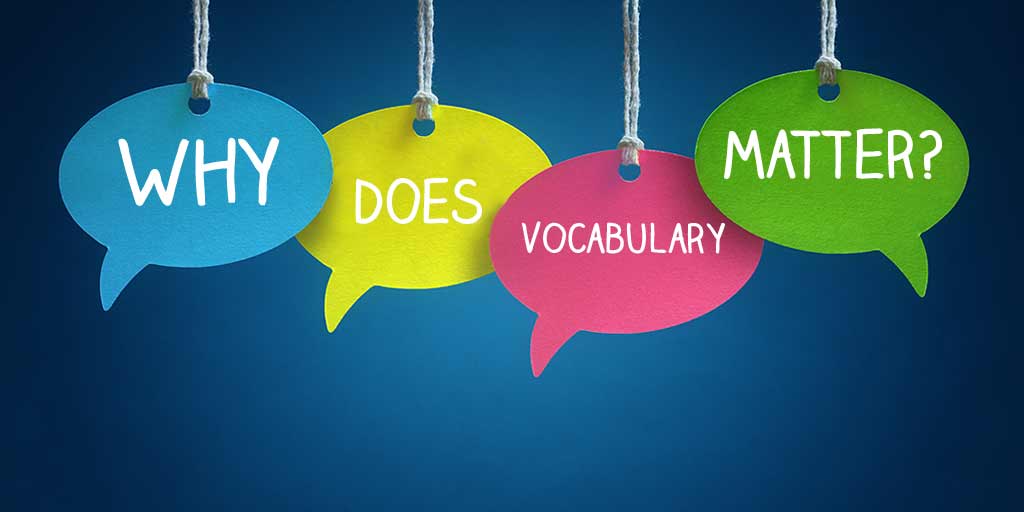Where is the value in meta-analysis?
Before I trained as a teacher, I worked as a researcher, investigating the effect of phytoplankton processes in the ocean. It appeared that in...

Login | Support | Contact us
Megan Dixon : Jan 16, 2019 1:32:00 PM
3 min read

A good vocabulary is an important building block for helping young children to communicate effectively, but it’s also essential to school performance more widely. Research consistently finds that the extent of a child’s vocabulary knowledge relates strongly to their overall academic success – a child’s vocabulary when they are five years old can tell us how well they may do at school at 11.
Vocabulary, and spoken language in general, is a key foundation for literacy. If children who have just started learning to read know the words they are reading, they can more easily and quickly sound out, read, and understand them, as well as comprehend what they’re reading: a solid vocabulary is the bridge between phonics and reading comprehension.
Teaching lists of words out of context can be a starting point for observation, and for conversations about language acquisition. But the emphasis for me should be on the use of vocabulary within the context of the entire language system. It can’t sit in isolation.
Perceptions of vocabulary learning are also contextually driven. I have worked with teachers where, against the standardised norms, the whole range of the language acquisition abilities of the children in the classroom is comparatively low, but this has become so normalised that they spot only the ones that are really, really low.
Conversely, many of the children in the schools where I work come to school without what you might call “book” or “academic” language, or conversational language. But within their homes and communities, in their context, of course they have language! What these children might lack is the language, or the so-called ‘cultural capital,’ to access what teachers expect in school. That simply means you have to teach it.
When I talk to teachers about teaching vocabulary, I relate it to the acquisition of language. So we might begin exploring ideas of phoneme correspondence, and expecting children to recognise a word – a task which is very difficult for them if they don’t have the word in their active vocabulary. If it’s not in their active vocabulary they have less idea of how it might sound or where the emphasis or stress may come in the word: it remains in effect a nonsense word, unless they have the skills to work out what it means in the context of the surrounding text.
If a teacher says that a child doesn’t know very many words, I would want to know what sort of words they don’t know; is it nouns, adjectives or verbs, for instance? We can then look at the types of words, or parts of words, that the children might be more familiar with, or that they lack.
In the classroom, vocabulary is low-hanging fruit: easy to grasp and observe, it provides a ready insight into some of the challenges that children can face as they learn. Yet while teachers have a sense of what vocabulary is, whether that is accurate or not is a really interesting question.
At Aspire, we talk quite a lot about diagnostic assessments, having a suite of little standalone assessments that help a teacher look more closely at each different aspect of literacy learning.
For example, we get children to spend 10 minutes with a paper and pencil and write down as many words as they know how to spell. When I asked year 6 teachers across the trust to do this, the number of correctly spelt words ranged from 3 to 118 over a group of around 200 children.
To understand what this tells us, we need to think about what the task requires. The children have to recall words they know how to spell: it isn’t the case that the child who only writes 8 words doesn’t know more, just that they can’t write them down.
From the words that they do write, you can begin to establish whether they have semantic networks, i.e. do they write blue, yellow, red, or do they appear to choose words more randomly? This, in turn, will have a bearing on their writing ability.
We need to be aware of what assessments can show us, and what they can’t. It is often assumed, for instance, that the DfE phonics screening check measures reading. But it doesn’t measure reading, it measures one aspect of reading.
There are a lot of reading assessments that are used all the way through school, to form the basis of judgments about children’s attainment. But we need to think critically: what do these assessments test? What does each really measure? Is the assessment a proxy, and if so, is it an appropriate proxy for what we actually want?
Megan Dixon is Director of Literacy for the Aspire Educational Trust, a small multi-academy trust based in the north west of the UK. The schools within the trust predominantly serve areas of high socio-economic disadvantage. Megan is also a founding Director of one of the EEF/IEE Research Schools. She holds a masters in literacy learning and acquisition, as well as a masters of teaching, and has recently started her PhD on difficulties around reading comprehension under the supervision of Professor Jane Oakhill. Megan’s work encompasses KS1 and early years all the way through to year 6. Her research interests include reading and writing acquisition for children, particularly those who find this challenging, and the translation of evidence into practice.
Read our case study to find out how the Cambridge Primary Insight for children aged 5-11 helps teachers identify common reading problems.

Before I trained as a teacher, I worked as a researcher, investigating the effect of phytoplankton processes in the ocean. It appeared that in...

1 min read
By Greg Ashman I suspect I would struggle to find a teacher who has never heard of ‘differentiation’. Exhortations to differentiate are ubiquitous in...

"Effective early years is the game changer." – Lydia Cuddy Gibbs, Head of Early Years, Ark Why the Reception year is so unique On day one of...